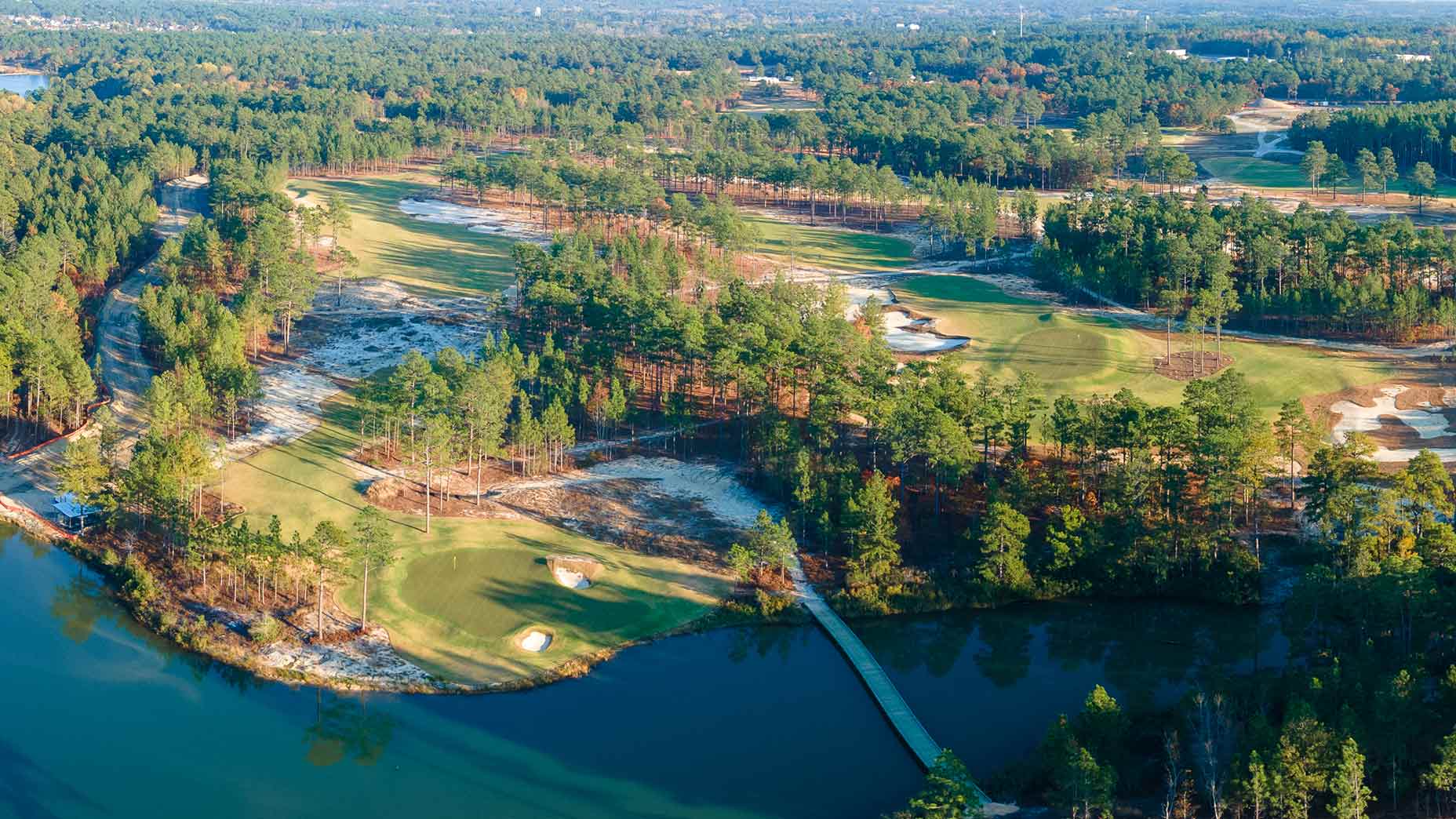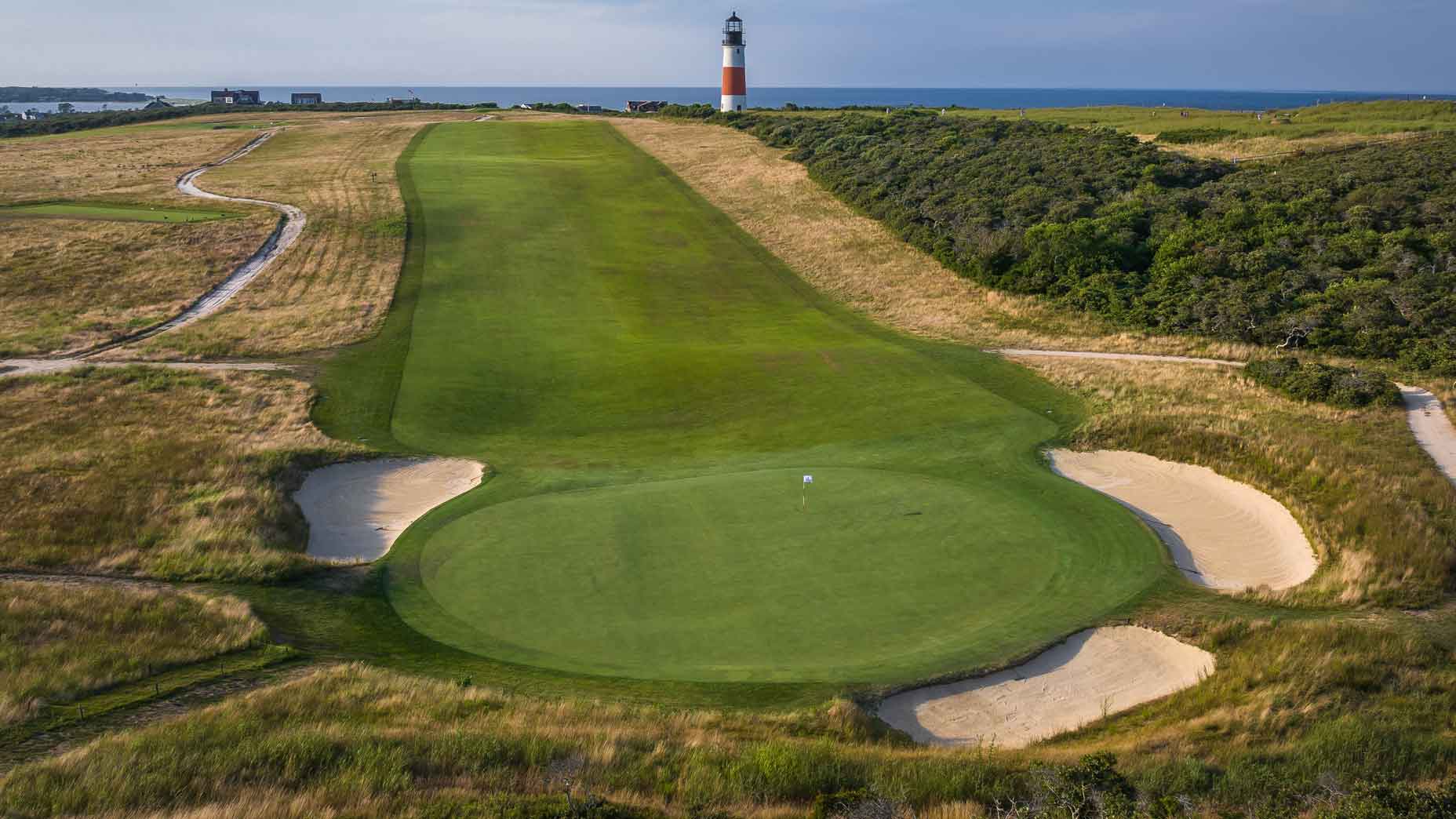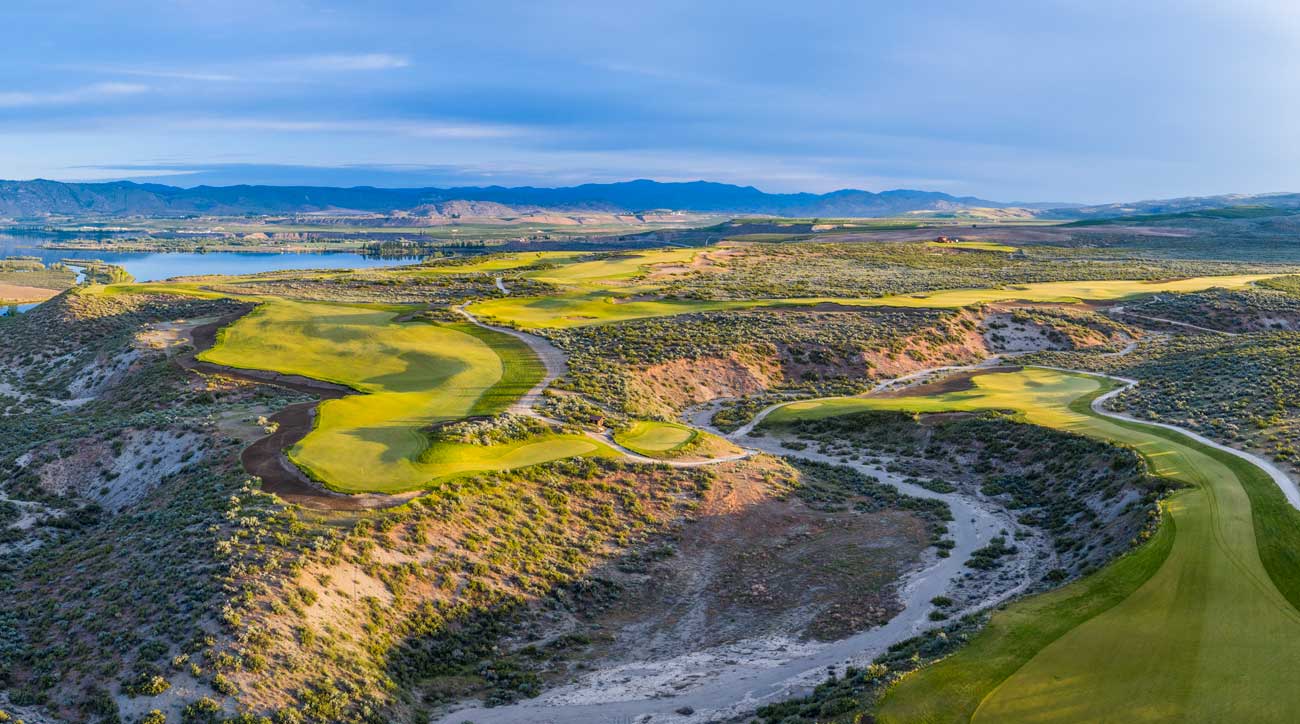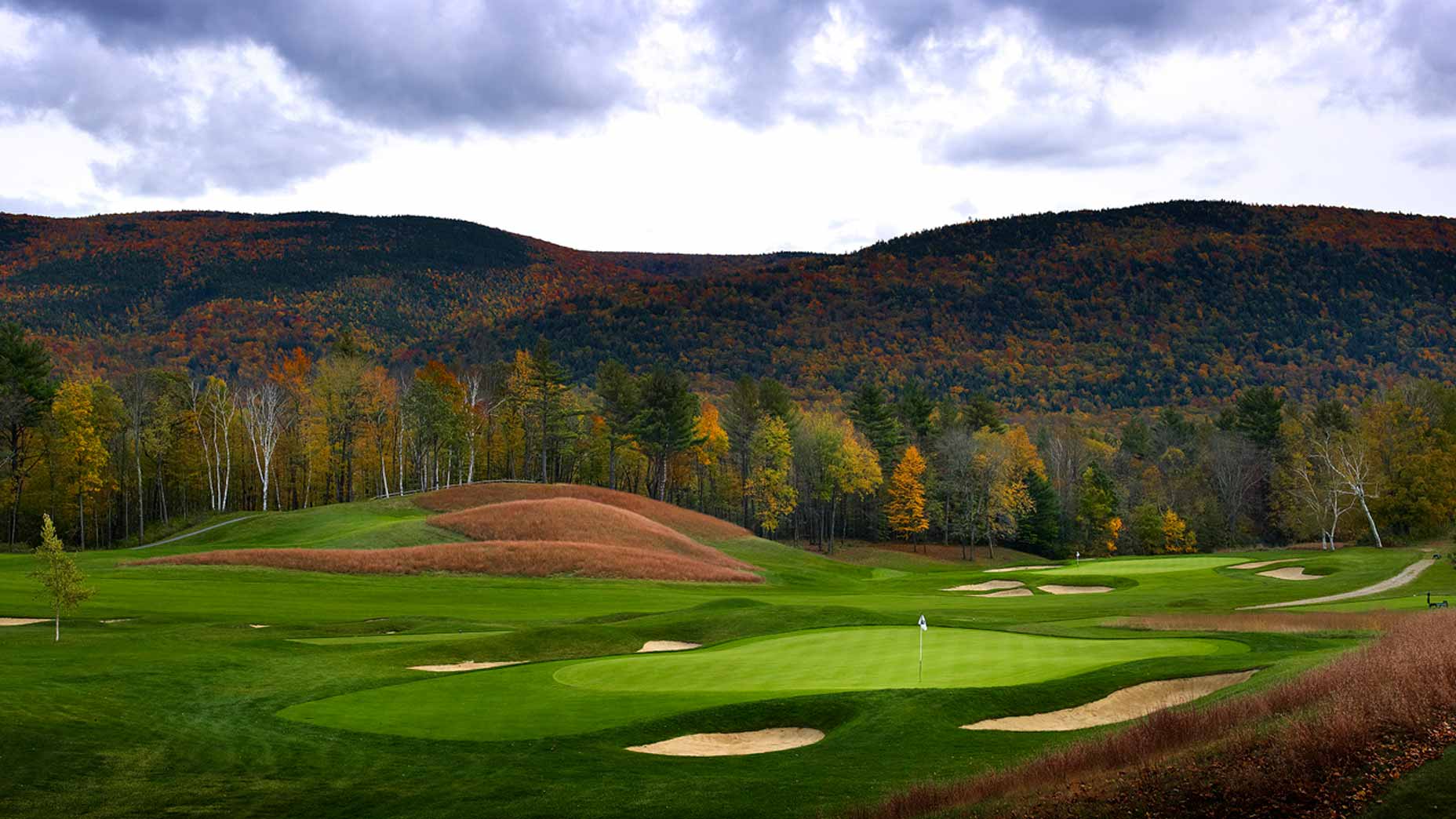GOLF’s latest ranking of the Top 100 Courses in the U.S. dropped this week, and while the top of the list featured the usual suspects — Pine Valley, Cypress Point, Shinnecock Hills, National Golf Links of America and Oakmont rounded out the top five once again — there were quite a few newcomers.
Eleven courses appeared on GOLF’s latest list for the first time or as returners. Those courses were from all parts of the country, and ranged from the newly-built, like California’s Ladera, South Carolina’s Old Barnwell and North Carolina’s Pinehurst No. 10, to masterfully restored, like Minnesota’s Interlachen and Illinois’ Medinah #3.
The Lido in Wisconsin made the list’s most impressive debut, though, coming in at No. 30. The course’s story is remarkable: Originally designed by C.B. Macdonald in 1917 in Long Island, the layout was highly regarded but was taken over by the U.S. Navy during World War II, never to be played again.
But The Lido was given new life by Sand Valley Resort operators Michael and Chris Keiser, who commissioned Tom Doak and Renaissance Golf to recreate The Lido in Wisconsin, which, with the help of original records and contemporary 3-D modeling, Doak did — to incredible effect.
How many of GOLF’s Top 100 Courses are in your state? Find outBy: Kevin Cunningham
Ten of the 11 newcomers to GOLF’s list are private courses, but there’s one standout that anyone can play: Pinehurst No. 10. Cracking the list at No. 88, Pinehurst Resort’s first new course in nearly three decades is another Doak masterpiece, and one of only two Pinehurst tracks that appear on the ranking. (U.S. Open anchor site Pinehurst No. 2 is No. 13.)
The varied landscapes of these sensational courses is a feast for the eyes. Check out all 11 newcomers to GOLF’s list below, and to browse the Top 100 Courses in the U.S. ranking in it’s entirety, click here.
GOLF Top 100 Courses in the U.S. newcomers
(Course descriptions by Ran Morrissett)

30. The Lido
Sand Valley, Wisc.
Tom Doak, Brian Schneider, 2023 (C.B. Macdonald reincarnation)
The Lido, on Long Island’s South Shore, opened for play in 1917, the work of C.B. Macdonald and Seth Raynor. The course met an unkind fate in the 1940s, but not until luminaries like Bernard Darwin had lavished praise on it; Darwin said he thought Lido was the best course in the world “as a battlefield for giants.” Well! Some eight decades later Michael and Chris Keiser decided to recreate the course adjacent to their Sand Valley Resort. Key to the equation was Peter Flory, who open-sourced hundreds of vintage photos of the original Lido and fed them into a software program that modeled the new Lido as accurately as possible. The Keisers then hired Tom Doak and Brian Schneider (who spent more than 230 days on-site) to build the course. This process included the use of GPS bulldozers, though discretion by Doak and Schneider was certainly required in getting the green contours just right. The scale of the course, the depth of its hazards and the size of the greens, which average over 12,000 square feet, is dazzling. Almost all of the great template holes are represented, from the Alps 10th to the Redan 16th, making this course a strategic marvel. Panelist Clyde Johnson calls Lido the “ultimate IQ test for golf-course architecture.” One of America’s great designs is back!

51. Old Barnwell
Aiken, S.C.
Brian Schneider, Blake Conant, 2023
Architects Brian Schneider and Blake Conant borrowed classic design principles and applied them in a fresh way on a sandy parcel of rolling land outside of Aiken. The firmness of the turf that superintendent Davis Verner routinely achieves (thanks, in part, to an absence of overseeding) allow the nuances of this design to sparkle. Half-par holes abound. Can you reach the open but long green at the par-5 opener? Should you drive try to the 2nd or 14th greens? (If you try and fail, the hunter quickly becomes the hunted as deep bunkers guard these two short 4s.) Can you use the mounds at the par-4 8th to kick an approach close on the inverted L-shaped green? Or how about trying to bounce one onto the rolling green at the 235-yard 11th? Meanwhile, the rust color of the centipede rough lends this open course a heathland-like feel. Completing the ideal is the club’s ethos of giving back to the game and the community, as established by Old Barnwell founder Nick Schreiber.

73. Interlachen
Edina, Minn.
William Watson, 1911; Donald Ross, 1919; Andrew Green, 2024
Andrew Green has mastered the playbook for restoring Golden Age parkland gems, and he did so again here outside Minneapolis where Bob Jones won one leg of the Grand Slam. Among the improvements: removal of poorly positioned trees; restoration of fairway width; and expanding Donald Ross’s greens to their fill pads. Green also reintroduced Ross’s bunkering schemes, and many of the greens are now surrounded by short grass. Ross’s routing across ridge lines creates memorable and distinctive holes such as the par-3 5th, par-4 6th, par-4 10th, par-5 12th and par-4 13th. The occasional water hazard adds to the diversity of obstacles that golfers must overcome. A well-played round here is deeply gratifying as the course poses every conceivable question of its challengers.

74. Medinah (No. 3)
Medinah, Ill.
Tom Bendelow, 1928-1932; Ogilvy, Cocking & Mead, 2024
One of the most recognizable courses in American golf returns to our Top 100 rank after an 8-year absence. The driving force was a homerun restoration by the Australian design firm of Ogilvy Cocking and Mead. Originally completed in 1932, No. 3 was arguably Tom Bendelow’s boldest and finest design, but playing host to major events took a toll as the narrow, heavily treelined course strayed far from its Golden Age roots. OCM removed poorly positioned trees and reverted to Bendelow’s bold bunkering as a unifying theme. The rolling property is once again both striking and spacious, and it’s laced with great holes throughout. The use of a split rail fence (which demarks out of bounds) at holes 5-7 provides excellent strategic tension, and holes 15 and 16 (the Cape 16th is one of five new holes created by OCM) are a blockbuster one-two punch.

82. Fox Chapel
Fox Chapel, Penn.
Seth Raynor, Charles Banks, 1925
This Tom Marzolf restoration was a strict return to Raynor’s 1925 vision, some of which had been lost based on advice that the club received from A.W. Tillinghast in the 1930s. Raynor fans are left with plenty to relish, including the Lion’s Mouth bunker brought back at 9, the Double Plateau green reinstated at 13 and the famous Bottle hole bunkering scheme returned at 16. All the approach areas were sand capped, with the resulting firmer surfaces allowing for short-game creativity. Additionally, short grass now surrounds the green pads, ensuring that options abound for recovery shots. Panelist Barry Doyle has suggested that Fox Chapel might now be home to Raynor’s best set of greens.

87. Ladera
Thermal, Calif.
Gil Hanse, Jim Wagner, 2023
Tucked away in the lower Coachella Valley, this private club nestles up against the Santa Rosa Mountains and provides one of the game’s most peaceful settings. Given that Jim Wagner and Gil Hanse manipulated every inch of this desert site, they were free to configure the fairways as best they saw fit. Several tee shots now require appealing diagonal carries over the likes of barrancas, low-lying vegetation and well-placed bunkers on the inside of doglegs. Standout holes include the 210-yard par-3 12th that features a Biarritz type swale at the rear of the green, and the drivable par-4 15th that plays to an elevated, angled green. The best of the bunch might be the 18th, with its massive bunker on the left working in perfect unison with a sister bunker front right. This is strategic golf at a high level.

88. Pinehurst No. 10
Pinehurst, N.C.
Tom Doak, 2024
Give a talented architect a sandy, rolling piece of land and place few restrictions on him or her, and it’s amazing what can be produced. Donald Ross did so with a flourish at this resort, and this time, it was Tom Doak’s turn — and he was bonused with not having to make an allowance for where homes might go or having the nines return. The result is a meandering tour that enjoys its own pacing. The first eight holes feature three par-4s — the drivable 4th, the burly dogleg-right 6th and the intermediate length 8th that plays into old mining spoils — that highlight the property’s diversity. Meanwhile, the run from the bruising uphill 468-yard 9th to the 264-yard 14th is one of Doak’s sternest stretches. Natural wetlands feature at two of the final four holes. This variety of obstacles ultimately make No. 10 an immediate stalwart among the resort’s offerings.

92. Sankaty Head
Nantucket, Mass.
H. Emerson Armstrong, 1923
According to panelist Roger Hoit: “Magical, mystical, whimsical, beautiful, fun — a day at Sankaty Head on the idyllic island of Nantucket is all of those things and more. Sankaty is course for everyone. It’s highly playable from the stress-free forward tees but also a stiff test from the back tees, especially in the prevailing southwest breeze, as players learned at the 2021 U.S. Mid-Amateur here. Jim Urbina did a wonderful job with a 2017 restoration of the original Emerson Armstrong design. Highlights include the 4th hole, a 520-yard reachable par-5 where a well-positioned drive sets up the opportunity to go for the green. The Sankaty Head lighthouse dominates the horizon for the second shot that requires navigating fantastic bunkering, including a trench bunker over the green. Another standout is the par-4 15th. The approach to this 410-yard hole is my single favorite shot on the course as it plays uphill with the iconic clubhouse and lighthouse looming on the horizon. Sankaty Head is one of the game’s great one-hit wonders as it was Armstrong’s only design.

94. Old Elm
Highland Park, Ill.
H.S. Colt, 1913
Harry Colt built Old Elm in 1913, in one of his rare North American visits. In the ensuing years, Donald Ross added his own touches, representing the only significant time these two design titans spent together. Fast forward 100 years and superintendent Curtis James has turned this course into a haven for short grass with some of the fastest and firmest playing surfaces in the country. Tee balls scamper forever, at least until they run into one of the Colt bunkers that architect David Zinkand has meticulously restored over the past decade. The bouncy playing surfaces also have turned some of the crowned greens — like on the world-class 2nd and 5th holes — into terrifying propositions. Colt never built features that scream at you; and such is the case at Old Elm, which is the kind of design you would like to wrestle with 30 to 50 times a year. You might not lose a ball playing here but you will wonder why you don’t quite play to your handicap.

96. Trinity Forest
Dallas, Texas
Bill Coore, Ben Crenshaw, 2016
Just south of the city center, this course shares many of the same playing characteristics of the Old Course at St. Andrews. The ground is rumpled, and much of the fun is derived from watching balls disappear over humps or down into swales — and wondering if they will reappear. Superintendent Kasey Kauff keeps Trinity’s Zoysia fairways at lightning speed, meaning trying to maintain control of your ball over these frictionless surfaces is quite the challenge. The PGA Tour conducted an event here for several years during the rainy season, cheating viewers from appreciating how fascinating — and strategic — this Coore & Crenshaw design really is. Today, the nines are again played in the sequence that Coore & Crenshaw intended, which means that the short par-3 17th, with its innovative double punchbowl green, is in the climactic position it deserves.

98. Philadelphia Cricket Club (Wissahickon)
Flowertown, Penn.
A.W. Tillinghast/1922; Keith Foster/2013
Keith Foster’s 2013 restoration, which features both great variety and spaciousness, brought all of A.W. Tillinghast’s design sparkle back. Some greens are open across the front and beg for a running shot while others are perched and heavily defended. The design reflects Tillinghast’s genius for diverse green settings. His famous trademark, the Great Hazard (a mammoth central bunker that bisects the fairway), is particularly well done at PCC’s 7th hole. The course also is home to one of the East Coast’s best finishers, a tough risk-reward par-4 with a creek that comes into play if you don’t hug the left side of the fairway off the tee.












